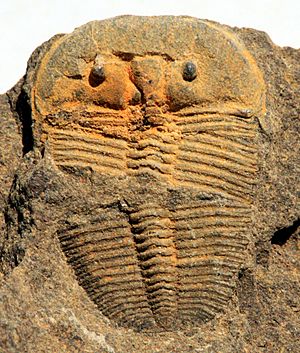Aulacopleura facts for kids
Quick facts for kids Aulacopleura |
|
|---|---|
 |
|
| Aulacopleura koninckii, Kosovu Beruna, Czech Republic | |
| Scientific classification |
|
| Kingdom: | Animalia |
| Phylum: | Arthropoda |
| Class: | †Trilobita |
| Order: | †Proetida |
| Family: | †Aulacopleuridae |
| Genus: | †Aulacopleura Hawle & Corda, 1847 |
| Type species | |
| †Aulacopleura koninckii Barrande, 1846
|
|
| Species | |
|
|
| Synonyms | |
|
Arethusa Barrande, 1846 non De Montfort, 1808, Arethusina Barrande, 1852 |
|
Aulacopleura is a type of ancient sea creature called a trilobite. Trilobites were a group of animals that lived in the oceans millions of years ago, long before dinosaurs. Aulacopleura lived from about 472 million years ago (during the Middle Ordovician) to about 385 million years ago (during the Middle Devonian). Some scientists think it might be a smaller group within another trilobite family called Otarion.
Contents
What Did Aulacopleura Look Like?
Aulacopleura had a body divided into three main parts, just like all trilobites.
The Head (Cephalon)
The head part, called the cephalon, was shaped like a half-circle or a half-oval. It had a clear border around its edge. The central raised part of the head, called the glabella, was short. Aulacopleura had eyes that varied in size. Sometimes, small ridges connected the glabella to the eyes. At the back corners of the head, there were pointed parts called genal spines. These spines usually reached back to the second to fourth segments of the body. The mouthpart, or "palate" (called the hypostome), was not attached to the top of the head shield. The surface of the head was often covered in tiny pits or small bumps.
The Body (Thorax)
The middle part of the body, known as the thorax, could have up to 22 segments. Each segment had side lobes, called pleurae, which usually had rounded ends.
The Tail (Pygidium)
The tail section, or pygidium, was quite small. It had a smooth, even edge. Interestingly, one species, A. koninckii, had a type of compound eye that was very similar to modern insect eyes.
How Did Aulacopleura Get Its Name?
The story of Aulacopleura's name is a bit like a mix-up! In 1846, a scientist named Barrande first described this trilobite and called it Arethusa koninckii.
However, the name Arethusa had already been used in 1808 for a different tiny sea creature called a foram. Because names can't be used twice, Barrande tried to fix this. He suggested a new name, Arethusina, in 1852. But before he could do that, two other scientists, Hawle and Corda, had already proposed the name Aulacopleura in 1847. Since their name came first after the original mistake, Aulacopleura became the official scientific name for this trilobite.
Where Did Aulacopleura Live?
Different types, or species, of Aulacopleura have been found in various parts of the world. These fossils help us understand where these ancient creatures once lived.
- A. andersoni was discovered in rocks from the early Silurian period in Australia. Specifically, it was found near Forbes, New South Wales.
- A. koninckii is known from the middle Silurian period in the Czech Republic. Fossils were found in the Liten Formation in Bohemia.
- A. krizi was also found in the early Silurian rocks of Bohemia, Czech Republic, in the Želkovice formation.
- A. letmathensis has been found in Germany, in rocks from the middle Devonian period.
- A. pogsoni was collected from early Silurian rocks in Australia, also near Forbes, New South Wales.
- A. sandfordi is another species found in early Silurian Australia, from the same area as A. andersoni and A. pogsoni.
- A. wulongensis comes from early Silurian rocks in China, specifically from the Sichuan region.

